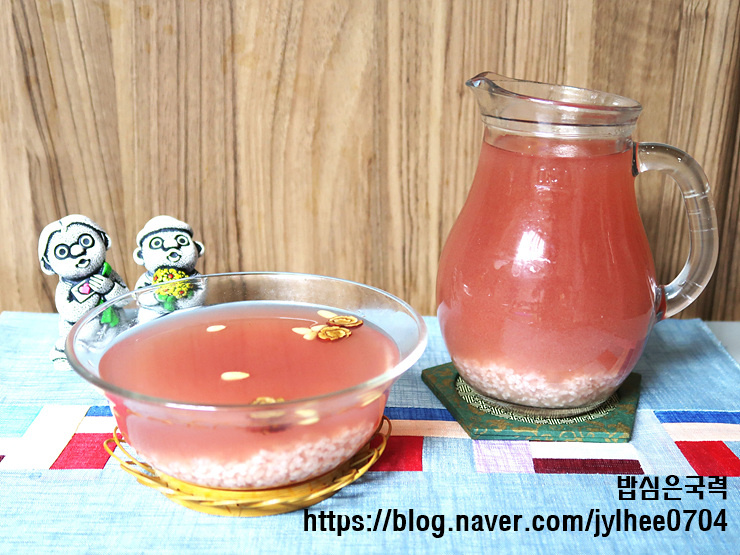Elegant Chuseok Beet Sikhye
The Essential Beet Sikhye for Your Chuseok Ancestral Table – Healthy & Beautiful!

As the abundant Chuseok holiday approaches, we’ll be making a special Beet Sikhye, a traditional Korean sweet rice drink perfect for ancestral rites. Adding beets gives the sikhye a more luxurious hue and its own wonderful health benefits, making it a delightful and wholesome beverage. Elevate your holiday with this visually stunning and nutritious drink.
Ingredients- 3 cups malted barley powder (using paper cups)
- 14 cups water (using paper cups)
- 1 cup sugar (using paper cups)
- 2 bowls cooked rice (using small rice bowls)
- 1/3 medium beet
- 1/3 medium piece of ginger
- A few jujubes (for garnish)
- A few pine nuts (for garnish)
Cooking Instructions
Step 1
First, measure out 3 cups of malted barley powder using a paper cup.

Step 2
Prepare 14 cups of lukewarm water by mixing hot and cold water. (measured with paper cups) Malted barley ferments best in lukewarm water, so controlling the temperature is key.

Step 3
Place the 3 cups of malted barley powder into a cheesecloth or a muslin bag. Gently knead and squeeze it in the lukewarm water to help release its starch and flavor. Let it sit for 2-3 hours. You’ll notice a sediment at the bottom, similar to starch. Carefully decant the clear liquid from the top, and discard the sediment. Including the sediment can make the sikhye turn a dark, muddy color.

Step 4
Pour the decanted clear malted barley water into a slow cooker. If you don’t have a slow cooker, you can use the ‘Keep Warm’ function on an electric rice cooker.

Step 5
Prepare 2 bowls of cooked rice (using small rice bowls). (A large bowl was used in the photo). To help the rice break down easily, microwave the rice for about 30 seconds to 1 minute. This makes it easier to mix with the malted barley water.

Step 6
Add half of the sugar (1/2 cup) to the malted barley water and stir well with a whisk until dissolved. Then, add the microwaved cooked rice and whisk again to break it up, ensuring the sugar and rice are well incorporated.

Step 7
Now, we wait for the rice grains to float to the surface. This fermentation stage is crucial for developing the sikhye’s sweetness and flavor.

Step 8
Let it ferment on low heat in the slow cooker or rice cooker’s ‘Keep Warm’ setting for about 4-5 hours. Instead of strictly adhering to the time, the key indicator is when about 10 rice grains float to the surface. This signifies that the sugars have been sufficiently released.

Step 9
After about 4 hours and 30 minutes, I observed that about ten rice grains had nicely floated to the top. Now it’s time to separate the rice grains from the liquid.

Step 10
Carefully scoop out the floating rice grains using a sieve. Rinse the collected rice grains gently in cold water 2-3 times to prevent clumping, then place them in an airtight container for later. While typically rice grains are boiled with the liquid, separating them and adding them back later results in a clearer sikhye without mushy grains.

Step 11
Wash the beet thoroughly, peel it, and slice it thinly and flatly. Place the sliced beet into a clean paper pack or a fine-mesh bag (like a dashi bag). Tie the opening securely with string. This prevents the beet pieces from floating into the liquid during boiling, keeping the sikhye clear.

Step 12
Peel and finely mince the ginger, then place it in the paper pack and tie the opening with string. Even a small amount of ginger adds a subtle, pleasant aroma that enhances the sikhye’s flavor profile. Mincing the ginger rather than slicing it thinly helps release more of its fragrance. Don’t forget to add the ginger!

Step 13
Pour the fermented malted barley water into a pot. Add the beet and ginger in their packs, along with the remaining 1/2 cup of sugar. Bring it to a boil over medium-high heat. Once boiling, reduce the heat to medium-low and simmer for about 5 minutes. Avoid boiling for too long, as it can make the beet color less vibrant.

Step 14
To achieve a more vivid beet color, I’ll be adding some blended beet juice to the sikhye liquid. This step is optional, but recommended if you desire a more striking hue.

Step 15
Strain the blended beet through a fine-mesh sieve to collect the clear juice. This process effectively extracts the beet’s beautiful red pigment into the liquid. The resulting crimson color is truly stunning.

Step 16
Serve the finished Beet Sikhye in a beautiful bowl. Top with the separately rinsed rice grains and the prepared jujubes and pine nuts for garnish. This elegant Beet Sikhye is perfect for your Chuseok ancestral table.

Step 17
Compared to regular sikhye, this Beet Sikhye boasts a noticeably more beautiful red color. Rinsing the rice grains in cold water helps them float nicely, making the sikhye visually appealing. Enjoy your delicious creation!



